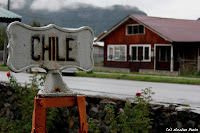El Chalten, self-proclaimed youngest village in Argentina, was founded in October 1985. The Argentine government's strategic vision was obviously to occupy this geographical region where the borders are still the subject of disagreement. In fact, here, Chile and Argentina are in agreement that there is a disagreement. That's a good start!
This little village of 1,000 inhabitants off tourists is also modestly call National Capital of Trekking. Okay, there are beautiful walks nearby in the foothills of Mt. Fitz-Roy and Mt. Torres, one-day or several-day hikes. Fitz-Roy, what a funny name down her! Not very Hispanic! In fact, this rocky peak was named in honor of Sir Robert Fitz-Roy (1805-1865), commander of HMS Beagle, which travelled up the Santa Cruz River in 1834 and charted large parts of the Patagonian coast.
 After a few days in El Chalten, I hit the road again: Ruta 40, the equivalent of the Carretera Austral on the Argentine side. The road is better paved, but absolutely no village, unlike Chile. It is a true desert, a windswept plain, large expanses of burnt grass. For example, between El Chalten and El Calafate (my next step), there are more than 200 km (125 mi), with just a small inn and restaurant in between. Considering that, it is easy to imagine how difficult it is to find people to hitch-hike. Either take the bus then.
After a few days in El Chalten, I hit the road again: Ruta 40, the equivalent of the Carretera Austral on the Argentine side. The road is better paved, but absolutely no village, unlike Chile. It is a true desert, a windswept plain, large expanses of burnt grass. For example, between El Chalten and El Calafate (my next step), there are more than 200 km (125 mi), with just a small inn and restaurant in between. Considering that, it is easy to imagine how difficult it is to find people to hitch-hike. Either take the bus then.
In El Calafate, little (actually nothing) to do. It's a dead place. And it's actually here that died former president Nestor Kirchner (husband of the current president). Except from learning that, I went 75 km away (50 mi) to visit the famous Perito Moreno Glacier. You also want to know where the name comes from? Perito, which means specialist or expert in Spanish, is a term often used to describe Francisco Moreno (1852-1919), director of the Museum of the Argentine Scientific Society and a great explorer of the southern region of Argentina (who played a important role for the defense of the Argentine territory in the border conflict that opposed Argentina to Chile. Well, well, again!). He also established Scouting and Guiding in Argentina.
The Perito Moreno looks a little like a meringue pie or a floating island (well, it was long ago since I last mentioned food in a post!). It moves in one leg - the Brazo Rico - of Lago Argentino, until it reaches the opposite bank (where visitors observe the glacier) and separate the Brazo Rico from the rest of the Lago Argentino. In this new small "lake", water can rise up to 30 meters above the rest of the Lago Argentino. This pressure on the glacier gradually hollow tunnel, which turns arch and eventually collapse. And the process begins again. Cycles can last two years for the shorter, up to 16 years for the longest recorded. Have to be there at the right time to see it all collapse. The last time was last year. But otherwise, every day swathes of ice break off. In a deafening noise, so it is the equivalent of a 25-storey building which collapsed and plunged into the water.
This is what is most impressive about this glacier, in the end. It is not necessarily more beautiful or more majestic than another. In fact, I almost preferred the glacier O'Higgins (see previous article): fewer tourists, more isolated, more difficult to access. And it was my first of its kind. However, the region and the glacier still worth a visit. You can judge for yourself...













